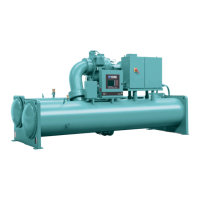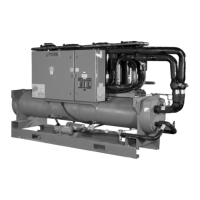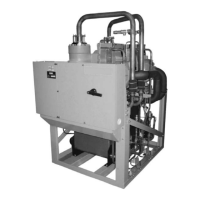The higher bus voltage is required for harmonic current correction at the input of the OSCD, and to
provide the correct output voltage for high speed operation of the compressor motor.
The AC to DC rectifier uses several power devices. Each phase has one or more modules arranged
in a parallel connection depending on the amount of input current required. Each rectifier module
contains 3 power devices that are called the Upper, Lower, and Aux. device. All three devices are
required to rectify and boost the 3 phase input AC voltage into DC voltage in a modified new three-
phase bridge configuration. The use of the modified new three-phase bridge configuration in the
rectifier permits pre-charge of the DC Bus filter capacitors when the chiller enters the start mode,
and provides a fast disconnect from the AC line when the chiller enters the stopped mode. This new
bridge configuration also provides the harmonic filtering without the need of separate power unit,
precharge circuit, and control board. Figure 45 and Figure 49.
The DC to AC inverter also uses several power devices. Each phase has one or more modules
arranged in a parallel connection depending on the amount of output current required. Each
inverter module contains an Upper and Lower device. The Aux. device is not needed in the inverter.
The permanent magnet motor used on the YMC
2
chiller requires a near sine wave of voltage.
Typically, drives provide a pulse of voltage at the amplitude of the bus voltage for a varying period
of time. This waveform is typically known as a square wave. This OSCD contains a direct water
cooled output inductor.
A new drive logic board was designed to provide all of the logic required to turn on and turn off all
of the power devices, turn on and off the cooling fans and pumps, evaluate data from the input and
output current sensors, evaluate data about the input and output voltage, and communicated to
the OptiView panel.
Other sensors and boards are used to convey information back to the OSCD Logic board (see
Figure 51), and provide safe operation of the OSCD. Each power module contains a temperature
sensor that provides temperature information back to the OSCD logic board. Two ambient
temperature sensors ensure that the internal temperature of the OSCD does not exceed a safe
operation level. Three Current Transformers monitor the output current from the OSCD power
unit and are used to protect the drive and motor from overcurrent conditions. Another 3 Current
Transformers monitor the input current to the OSCD to provide current limit, ground fault
detection, and information for the harmonic current filtering.
Smart sensor system
The smart sensor system provides an early detection of localized overheating due to loose high
power electrical connections, or components that have not raised the ambient temperature of the
enclosure to the VSD ambient temperature fault level. When smart sensors detects a fault, a signal
is sent to the smart sensor board. The smart sensor board then commands the circuit breaker to
open through the circuit breaker's shunt trip.
The smart sensor system does not communicate to the drive logic board. A flip dot on the smart
sensor board displays black under normal conditions. If the system is triggered, the flip dot
displays red, and opens the circuit breaker. The flip dot does not require power to display.
Reapplying power to the chiller resets the flip dot to black, and the reason the circuit breaker
opened is lost.
The following figures show the black flip dot and the red flip dot in the circled area.
YMC
2
Mod B with OptiView
™
Control Center
142

